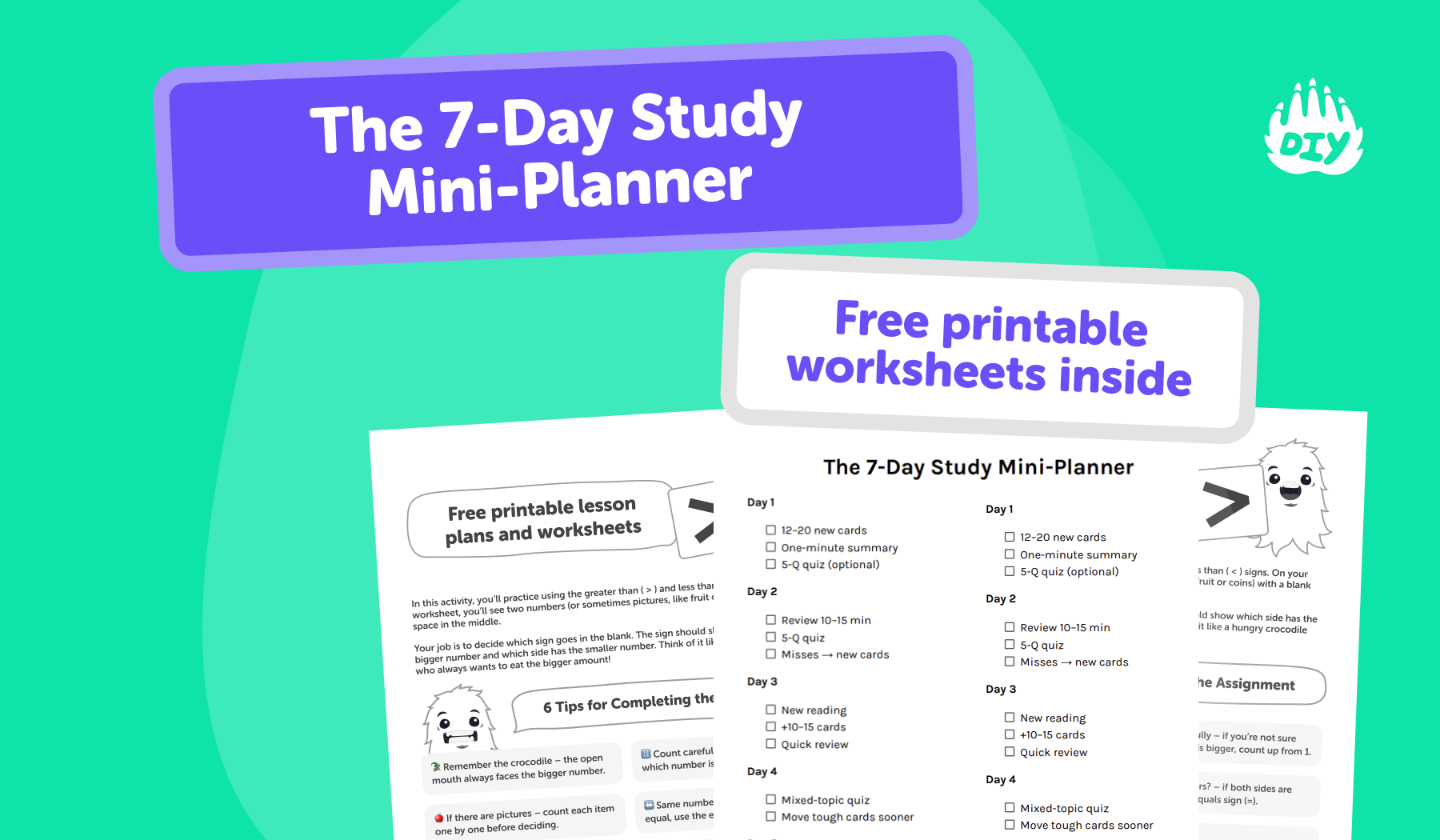Study smarter in 10–20 minutes a day with a simple loop: make flashcards (active recall), take a 5-question quiz (testing effect), then write a one-minute summary (teach it back). Use an AI flashcard generator and AI quiz maker to draft fast, then tweak for your class vocab. With spaced repetition hard cards sooner, easy cards later you’ll remember more, stress less, and build steady study habits that actually stick.
Why this works (and why cramming doesn’t)
Cramming feels productive. Real learning sticks when you use three habits:
Active recall pulls answers from memory (flashcards).
Testing affects short quizzes to spot gaps.
Spaced repetition quick sessions spread across the week.
This guide shows a simple loop that fits any class: flashcards → quick quiz → one-minute summary.
The 3-Part Routine (10–20 minutes a day)
1) Flashcards that actually work
One concept per card.
Make both term → definition and definition → term versions.
Add a plain-language example.
Review daily; space tough cards closer together.
Using an AI flashcard generator? Let it draft, then you edit for clarity, course vocabulary, and difficulty.
2) Quick quizzes to catch gaps
After each session: 5 questions (2 MCQ, 2 short-answer, 1 application).
Tag misses and turn them into new cards.
Once a week, mix topics to avoid “unit-only” knowledge.
Using an AI quiz maker? Great for a fast first pass. You still refine stems and distractors.
3) One-minute summaries
Close your notes and explain the idea in 5–7 sentences.
Use the “teach a friend” vibe; include one analogy.
If you get stuck, you found a weak spot and add a card or two.
Sample Set #1: Biology Photosynthesis
Smart flashcards
Q: What’s chlorophyll’s main role? A: Absorbs light to power reactions in the thylakoids.
Q: Where do light-dependent reactions occur? A: Thylakoid membranes.
Q: Which two molecules power the Calvin cycle? A: ATP and NADPH.
Q: Name the carbon-fixing enzyme. A: RuBisCO.
Q (reverse): Which stage uses ATP/NADPH to fix CO₂ into sugars? A: Calvin cycle.
Micro-quiz (5 items)
MCQ: Which factor most limits photosynthesis at low light? A. CO₂ • B. Light intensity • C. Temp • D. pH
MCQ: Photosystem II splitting water produces: A. NADH • B. O₂ + H⁺ + e⁻ • C. Glucose • D. FADH₂
Short answer: Name the two energy carriers from light reactions.
Short answer: Where does the Calvin cycle occur?
Application: If NADPH is depleted, which step stalls and why?
One-minute summary (filled) “Photosynthesis captures light to charge energy carriers (ATP, NADPH) and then uses them to build sugars from CO₂. Light reactions in the thylakoids release oxygen from water; the Calvin cycle in the stroma assembles glucose. Low ATP/NADPH slows sugar building like running low on batteries.”
Sample Set #2: History American Revolution (concept overview)
Smart flashcards
Q: Primary colonial grievance in the 1760s–1770s? A: Taxation without representation.
Q: Two acts that escalated tensions? A: Stamp Act (1765), Townshend Acts (1767).
Q: Why the Boston Tea Party mattered? A: It triggered the Coercive/Intolerable Acts.
Q: Core claim of the Declaration of Independence? A: Natural rights + consent of the governed.
Q (reverse): 1781 battle that ended major fighting? A: Yorktown.
Micro-quiz (5 items)
MCQ: The Proclamation of 1763 mainly: A. Encouraged settlement • B. Limited westward expansion • C. Cut tea prices • D. Drafted colonists
MCQ: The Intolerable Acts responded to the: A. Boston Massacre • B. Boston Tea Party • C. Lexington & Concord • D. Olive Branch Petition
Short answer: Define “consent of the governed.”
Short answer: Name one foreign ally who aided the colonists.
Application: How does a boycott work as political leverage?
One-minute summary (filled) “Tensions rose as Britain taxed the colonies without representation and tightened control after protests. Conflict escalated to war. The colonies argued for independence on natural rights and consent of the governed, won key battles with foreign help, and secured victory after Yorktown.”
Build it into your week: a 7-day mini-plan
Day 1: Read a section → draft 12–20 cards → one-minute summary.
Day 2: Review 10–15 min → 5-question quiz → turn misses into cards.
Day 3: New reading → add 10–15 cards → quick review.
Day 4: Mixed-topic quiz; move tough cards closer.
Day 5: Focus on weak areas; rewrite unclear cards; update summary.
Day 6: Cumulative review + 7–10 Q quiz.
Day 7: Light spaced review, organize notes, rest.

Want a coach that guides, not shortcuts?
Try an AI study helper that drafts cards and quizzes, then puts you in the driver’s seat to refine, practice, and test.




